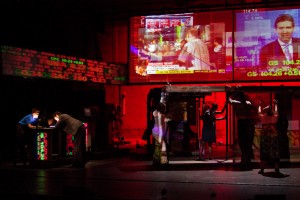House/Divided: From the Great Depression to the Great Recession

Photo Credit: James Gibbs
House/Divided at ArtsEmerson
House/Divided is a politically leftist work, part docudrama and part story, devised by the Builders Association, a long-term collaborative based in New York, which has toured worldwide. ArtsEmerson presented House/Divided at Boston’s Cutler Majestic from January 30 to February 2.
The intermedial production makes use of yesterday’s scrims and today’s screens as well as live and recorded music. Almost nothing has solidity, not even the house that is “built” at the production’s start and remains center stage in various iterations as a symbol of the events taking place.
House/Divided juxtaposes the Great Depression and the Great Recession. The 1930s scenes, with dialogue and narration drawn from John Steinbeck’s The Grapes of Wrath, focus on the Joads’ loss of their house and farmland, followed by their desperate journey from Oklahoma to California in the hope of finding work.
Three quarters of a century later, the US tumbled into another economic crisis, also caused by a housing bubble, which nearly brought down Wall Street. In contrast with the slow-moving thirties – as presented here – of the Joads, contemporary America is frenetic and noisy. Projections and videos are ceaseless. Whenever money is discussed, which is frequently, brightly lit stock market reports move round the upstage screens. What has not changed is the greed of speculators. The bankers who dispossessed the Joads have their counterparts in the twenty-first century’s traders, real estate moguls, and global financiers.
The audience sees the Joad family through layers of scrim as if looking into a hazy past. Silent black and white films of the American landscape seem to accompany them as they drive across the country. By contrast, the Recession is portrayed as a series of vignettes. Most of the contemporary characters appear on screens in supposedly real time, sometimes as actors playing well-known national figures as, for example, Alan Greenspan. Others are interviewees, who had emerged from the real estate crash either as winners or losers, and allowed themselves to be videotaped. In a touch of irony, the interviews are projected onto screens above the house at center stage. Perhaps the most interesting and touching of the respondents is a young graduate student, who had been able to earn enough money to buy a house, lost her job, and found herself homeless. A few characters such as the two traders and an ethical bank employee appear on stage rather than on screen.
The numerous and diverse roles are played by a cast of six, making it impossible for them to develop their characters in any depth. But traditional storytelling and realistic characterization are obviously not the focus of director Marianne Weems or writers James Gibbs and Moe Angelos. Weems and the writers’ imagination seems absorbed by technological imagery that represents the century we inhabit. While there are striking moments, too often I felt overwhelmed by the visuals. Intermedial theatre, which has grown considerably over the last few years, can become tedious when it takes over the production.
House/Divided
Inspired by The Grapes of Wrath
DIRECTED BY Marianne Weems
WRITTEN BY James Gibbs and Moe Angelos
SOUND DESIGN AND ORIGINAL MUSIC COMPOSITION BY Dan Dobson
VIDEO DESIGN BY Austin Switzer
LIGHTING BY Jennifer Tipton and Laura Mroczkowski
SCENIC CONCEPT AND DESIGN BY John Cleater and Neal Wilkinson
CAST
Moe Angelos, Jess Barbagallo, Sean Donovan, Matthew Karges, LaToya Lewis, David Pence